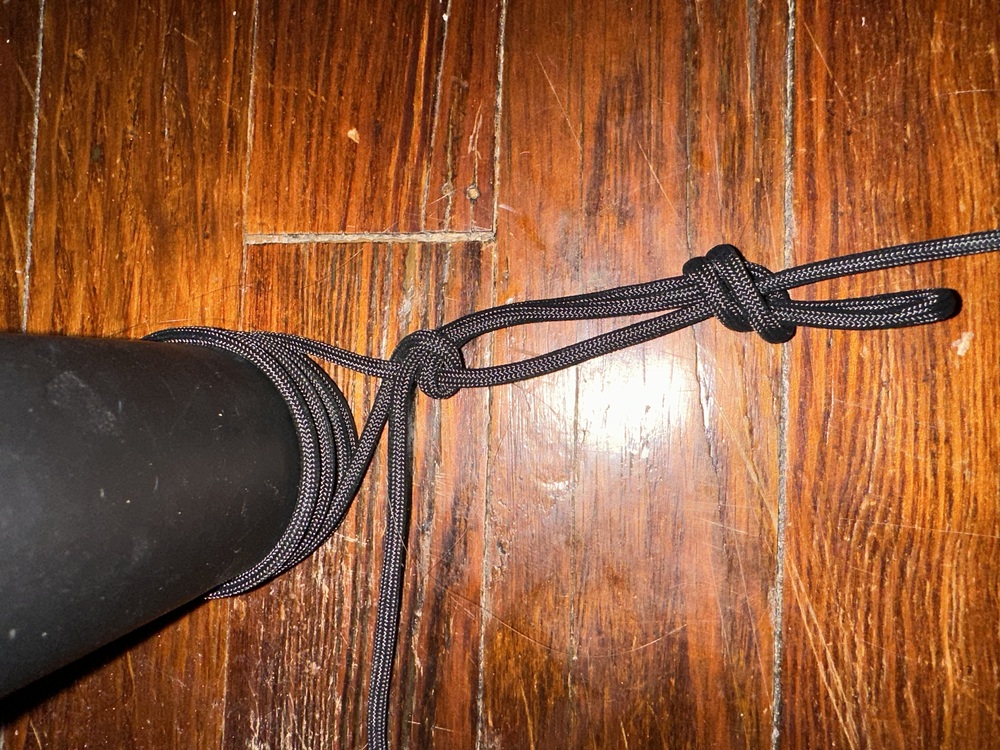Closing a tensionless hitch with a mule-overhand?
|
|
I’ve been curious about ways to remove the carabiner for a tensionless hitch while still being able to close the hitch with a bight-knot (no free end required). We regularly use the mule-overhand knot to close the system on a munter (and ATC), so I’m wondering why the same logic wouldn’t apply here? Advantages: less gear means a simpler system (no need to worry about the gate being locked, etc), the opportunity to secure yourself with one less biner Disadvantages: some possible rope-on-rope movement, although not much. Requires more knowledge to tie & inspect
Example photo below: (tied with paracord instead of rope, around a couch leg instead of a tree) |
|
|
I always hate these threads because I feel like a stupid old dinosaur that only knows 3 or 4 basic knots.. But I get lifted up with all the great responses from climbers that really know their geeky shit and that makes me happy that climbers are so learned up like that. Good luck with your topic brother, I bet it gets neato af for you. edit- oh yeah, don't sling trees, that's totally bad for the trees. |
|
|
Maybe skip the mule and tie just the overhand? It's tensionless and all... |
|
|
It should work. It's tensionless after all. I've also used a figure 8 tied around the load side (rethreaded as if tying in to your harness) along with a stopper knot. If I were closing the system with a carabiner that would be connected with an overhand or figure 8 on a bight anyways, which is the same thing. |
|
|
Chuck Parkswrote: That makes some sense. Using a half a double fisherman’s might work well too as something a little stronger than an overhand |
|
|
Jake woowrote: Thanks! The rethread figure 8 works great, but my problem with it is that it requires a free end. If you have a lot of spare rope, it becomes somewhat annoying to pull the full rope through each pass |
|
|
Use the bight to tie a Buntline hitch. Basically, you tie a clove hitch (which you should already know) around the standing end. |
|
|
Ryan Awrote: Didn't you already pull all of this extra spare rope around the tree 3 or 4 times to get to this point? Usually I'm tying my frictionless hitch at the starting end of my rope and then if using the same static line for an additional point I use a doubled up bowline (take a long bight and tie a bowline around the tree with it) or whatever it's called. Also also, if you've tied your frictionless hitch and have tons of spare rope, you can still tie a rethreaded fig 8 around the load strand. Same as the doubled up bowline, just use a long bight and you wind up with a ginormous knot. Happy to be part of the knot nerd talk |
|
|
You’ve given a tensionless hitch more thought than it deserves |
|
|
“half a double fisherman’s”
|
|
|
Please excuse asking an obvious question, but what exactly are you using a tensionless hitch for? This is a familiar hitch for anchoring (though I’ve not seen it used commonly for recreational climbing), but I’ve usually seen it tied using the end of the rope. Why would you be using it in the middle somewhere? |
|
|
Ryan Awrote: that's the big hang up for me. you're replacing the "industry standard" way to close a tensionless anchor with a non-standard way. if i saw this in a system, i would stop and need to inspect it more closely. if i saw a tensionless hitch closed with a biner, that's an easy check mark in my book.
is it safe? yea, probably. should you do it? i don't see a reason why... |
|
|
Hank Caylorwrote: If you really wanting some GIGA Geeky knot stuff…
And if you really want your mind blown, skip to 24:22 |

 Continue with onX Maps
Continue with onX Maps Sign in with Facebook
Sign in with Facebook




















